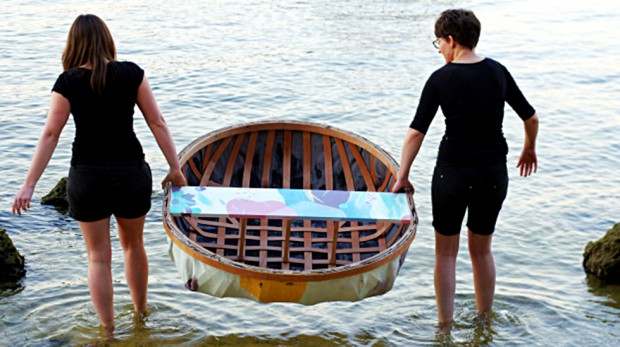
Renae Coles and Anna Dunnill have been collaborating this year as an art duo called Snapcat, and have been residence at the Fremantle Arts Centre since May, working on a project and performance as part of Horizon: Exploring The West Coast With The Clipperton Project. Dunnill spoke to us about the genesis and execution of their project and their one-off performance which took place on a rainy afternoon in East Fremantle.
Historically, Coles and Dunnill have worked in different roles in arts administration, arts management, and as writers and visual artists, but Dunnill says, “We felt like we didn’t have many traditional art skills, or just life skills. Neither of us could really cook or keep plants alive.” So they set out to learn new skills both in traditional handicraft and eventually survival skills. “It became a lot about survival and using art as a means to survive, so we decided to make these two small boats called coracles.”
The coracle is an ancient form of boat that was used in Ireland and Wales, and is still currently used in India, Vietnam and Tibet, on rivers and often in pairs, with nets dragged between two boats to catch fish. “Building the coracles included a lot of skills that we didn’t have yet but we had to learn along the way, and also it seemed like a challenge that we would be able to meet,” explains Dunnill. They followed instructions they found online from a Finnish boat hobbyist, and used a heat gun to shape the maritime plywood into these one-person boats, which they then painted in bright colours.
“We were drawn to the distinct amateurism of coracle building. They’re really unwieldy boats; all the examples that we found were built by amateurs on the weekends, and while they used to be built by fishermen, it’s the kind of thing that’s not produced commercially. They’re quite hard to control, and part of the project was about putting our safety in the hands of something that we had built completely, something that looked precarious.”
The ultimate outcome of building the coracles was to create a performance incorporating the skills that Coles and Dunnill had learned from books like The Girls Handbook and scouting handbooks, skills such as knot-tying, building fires, and survival communication in the form of heliographs, maritime flags and semaphore. The performance became a ritualistic leaving ceremony where Dunnill and Coles walked down to the river with the boats and invited audience to participate in the artwork.
Each audience member had a special role in the ritual, like building a fire, drumming, and responding to semaphore signals the women gave from the boats. In addition, two audience members filmed it, one on an iPhone, the other on a handycam, which provided two of five different documented perspectives on the event. Dunnill and Coles each used a GoPro, and also had a professional filmmaker film as well. As a result, Dunnill says, “We’ve made a five channel video installation from that footage that starts and ends at the same time and shows different angles of the performance from different points of view.”
This video installation is on exhibit at Fremantle Arts Centre until January, but Dunnill says beyond that, “Snapcat is going to continue to collaborate; we’ve got a few projects lined up for next year, so we’re hoping to continue to explore participatory performance, learn other DIY skills and keep using the ones we’ve already learned.”
CICELY BINFORD
Horizon: Exploring the West with The Clipperton Project continues at the Fremantle Arts Centre until Friday, January 9. For more information, go to fac.org.au.